Date of Issue:2020.8.1
<プロフィール>
Vice President, Community
Be My Eyes
◆ 特別インタビュー/No.399 (English edition)
テクノロジーの力と助けあいの気持ちで視覚障がい者の「目」になる―Be My Eyes―
Mr. Will Butler
Vice President, Community, Be My Eyes
Be My Eyes(ビー・マイ・アイズ)は、視覚障がい者・ロービジョンの人(視覚に障がいがあるため生活に何らかの支障をきたしている人)のために作られたアプリで、手助けが必要なときに視覚障がい者が、アプリを通じてコールをすると、ボランティアとスマホのビデオ通話でつながります。ボランティアは、視覚障がい者の送ってくるパッケージや書類の動画を見ながら、字を読み上げたり色や形を説明したりして、「目を貸す」サポートをします。
2015年に、アプリが発表されてから、現在では150か国以上、180以上の言語で、20万人以上の視覚障がい者のユーザーと、400万人近くのボランティアが登録する、大きなコミュニティーに成長しています。
その始まりから、これまでに苦労されたことなど、Be My Eyes でコミュニティ担当 Vice President を務める Will Butler(ウィル・バトラー)さんに伺いました。
その始まりから、これまでに苦労されたことなど、Be My Eyes でコミュニティ担当 Vice President を務める Will Butler(ウィル・バトラー)さんに伺いました。
― まず、ビー マイ アイズは、どのように始まり、これまでどのように成長してきたのか教えてください。
ビー マイ アイズは、デンマーク人の男性、ハンス・ヨルゲン・ワイバルグ(Hans Jørgen Wiberg)のアイデアから始まりました。
彼自身、網膜色素変性症(もうまくしきそへんせいしょう)という視力が落ちていく病気にかかっています。ビデオチャットが出てきたころ、助けが必要なときに、これは便利だと思ったそうですが、だからと言って、毎回ちょっとしたことで、友だちや家族に電話するのは悪い。一方、外に出ると、いつも心よく手助けしてくれる人がたくさんいる。とは言っても、四六時中助けが必要なわけでもない。
そこで、助けを必要とするときに、視覚障がい者と、手を貸してくれる人たちをテクノロジーで繋げることができたらと考えたのが始まりです。それが2015年に、『ビー マイ アイズ』のアプリになりました。
ユーザーが必要なときにコールボタンを押すと、携帯の向こうのボランティアで最初に電話をとった人につながる仕組みです。いわば、視覚版ウーバーです。
彼自身、網膜色素変性症(もうまくしきそへんせいしょう)という視力が落ちていく病気にかかっています。ビデオチャットが出てきたころ、助けが必要なときに、これは便利だと思ったそうですが、だからと言って、毎回ちょっとしたことで、友だちや家族に電話するのは悪い。一方、外に出ると、いつも心よく手助けしてくれる人がたくさんいる。とは言っても、四六時中助けが必要なわけでもない。
ユーザーが必要なときにコールボタンを押すと、携帯の向こうのボランティアで最初に電話をとった人につながる仕組みです。いわば、視覚版ウーバーです。
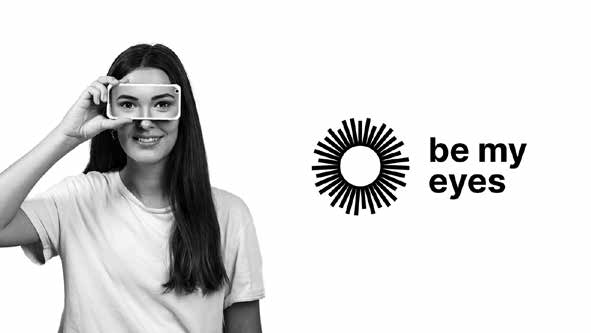
― ワイバルグ氏が、アプリを開発したのですか?
技術的なサポートが必要だったので、クリスチャン・エルフルト(Christian Erfurt、現CEO)と組んでアプリを開発し、この2人がビー マイ アイズの共同創設者となりました。
現在は、17名のスタッフがデンマークとアメリカで業務にあたっています。デンマークでは、4名のウェブディベロッパーが、アンドロイド、iPhone、ウェブブラウザの3つのアプリを管理・開発しています。世界中で使われているアプリをたった4人で、すごいでしょう!
ほかに、コミュニケーション部門など、組織運営のコアの部分がデンマークに、パートナーシップやビジネスモデルに関する業務を行なっているスタッフが、私も含めてアメリカに4、5名います。
現在は、17名のスタッフがデンマークとアメリカで業務にあたっています。デンマークでは、4名のウェブディベロッパーが、アンドロイド、iPhone、ウェブブラウザの3つのアプリを管理・開発しています。世界中で使われているアプリをたった4人で、すごいでしょう!
ほかに、コミュニケーション部門など、組織運営のコアの部分がデンマークに、パートナーシップやビジネスモデルに関する業務を行なっているスタッフが、私も含めてアメリカに4、5名います。
 Hans Jørgen Wiberg さん
Hans Jørgen Wiberg さんBe My Eyes 創設者、家具職人でもある
我々は非営利団体ではなく、社会的企業(social enterprise)で、視覚障がい者のコミュニティーを支援したいという世界中の企業とのパートナーシップで運営しています。大手では、グーグル、マイクロソフト、プロクター&ギャンブル(P&G)などがパートナーです。
パートナーになると、企業はビー マイ アイズのソフトウェア技術を使えるようになります。自社の従業員を支援するためにソフトを使えるほか、CSR事業としても、パートナーシップが役立っています。
また、企業のほかに、非営利団体のパートナーも多くいます。
例えば、盲導犬団体、視覚障がい者のリハビリを支援する団体。ほかにも、ブラジルのパラリンピック協会、インド、アメリカの団体など、世界中にパートナーがいます。最近、イタリアの非営利団体とパートナーを組み、イタリア語専門のサービスが始まりました。
パートナーになると、企業はビー マイ アイズのソフトウェア技術を使えるようになります。自社の従業員を支援するためにソフトを使えるほか、CSR事業としても、パートナーシップが役立っています。
例えば、盲導犬団体、視覚障がい者のリハビリを支援する団体。ほかにも、ブラジルのパラリンピック協会、インド、アメリカの団体など、世界中にパートナーがいます。最近、イタリアの非営利団体とパートナーを組み、イタリア語専門のサービスが始まりました。
― ボランティアになるには、登録するだけですか?
そうです。その簡易さがビー マイ アイズの素晴らしいところです。個人が登録してボランティアになることもできるし、グーグルのような大企業も参加できる。
グーグルには、ビー マイ アイズの電話を、専門に受け付ける部署があります。パートナー企業や団体で専門のラインを作っているところとは、マイクロソフト、P&G、盲導犬団体など、ユーザーが特定して電話をかけることもできます。
グーグルには、ビー マイ アイズの電話を、専門に受け付ける部署があります。パートナー企業や団体で専門のラインを作っているところとは、マイクロソフト、P&G、盲導犬団体など、ユーザーが特定して電話をかけることもできます。
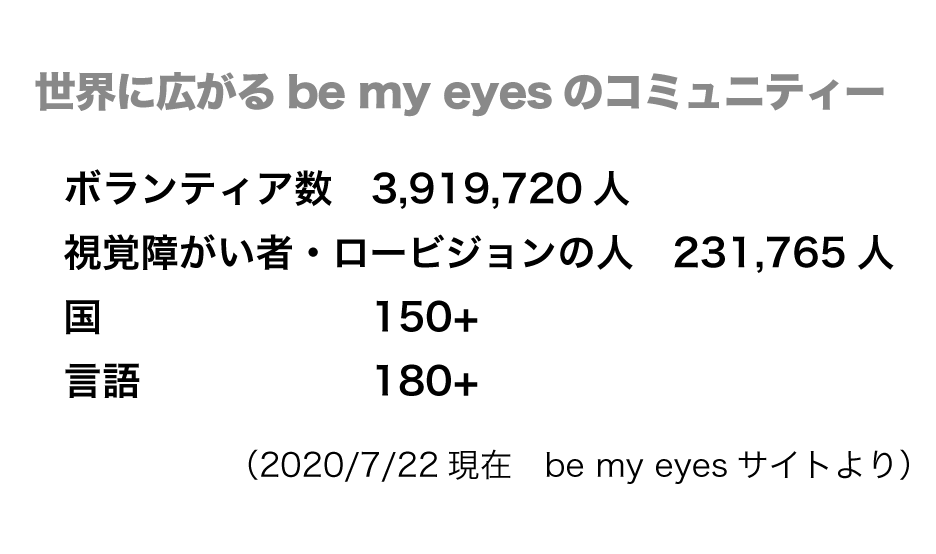
その通り。25万人近い視覚障がい者がビー マイ アイズのユーザーとして集まっています。そして世界には、もっともっとこのサービスを必要としている人たちがいる。この数はビジネスにとっても、意味のある数字です。
最初の企業パートナーは、マイクロソフトで、技術面、デザインに対するフィードバックなど、これまでさまざまな形で支援をしてくれています。
また、女性が、妊娠検査薬を使用した際、視覚障がいがあると検査結果を読めないという問題がありました。これを受けて、ビー マイ アイズから、P&Gの専門家に匿名で電話できるサービスができました。
また、女性が、妊娠検査薬を使用した際、視覚障がいがあると検査結果を読めないという問題がありました。これを受けて、ビー マイ アイズから、P&Gの専門家に匿名で電話できるサービスができました。
― これまでに特に大変だったことは何ですか?
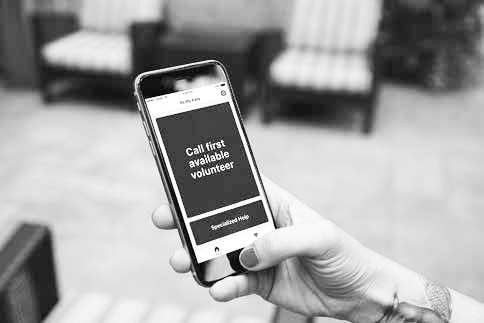 視覚障がい者のスマホ画面
視覚障がい者のスマホ画面最初は何の収入もなく、微々たる予算でやっていました。アプリの使用を有料にしたらどうか、宣伝を入れたらどうかなど、いろいろなアイデアやアドバイスがありました。でも、障がいのない人なら当たり前にしている生活を可能にするために、視覚障がい者だから料金を払わなければいけないというのはおかしい。だから、アプリの使用は無料にするべきという信念がありました。
企業にとっては、視覚障がい者コミュニティーへのアクセスを得ることになり、双方にとって利益のある、ウィン・ウィンの関係だと思います。
― 心に残るエピソードは?
感動的なエピソードは毎日です。よくあるのが、食べ物のパッケージについての電話。
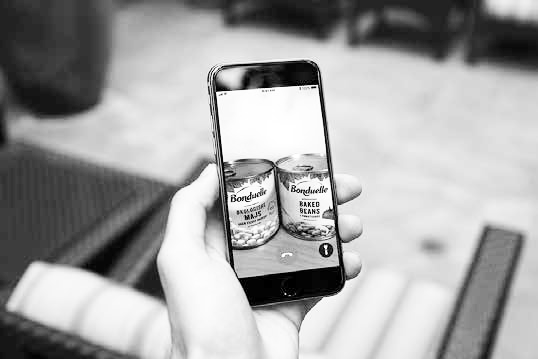 コーンはどっち?
この缶詰はコーン、それとも豆?視覚障がいがあると、どちらなのか分からず困るところですが、ビーマイ アイズのアプリで、ボランティアに電話すると30秒で問題が解決します。ボランティアも人助けができて、良い気分になる。こんな瞬間が、世界中で毎日何千回と起きているんです。
また、視覚障がいのある花嫁さんが、結婚式の当日、バージンロードを歩く前にドレスをチェックしてほしいと言って電話がかかってきたという話を聞いたことがあります。
コーンはどっち?
この缶詰はコーン、それとも豆?視覚障がいがあると、どちらなのか分からず困るところですが、ビーマイ アイズのアプリで、ボランティアに電話すると30秒で問題が解決します。ボランティアも人助けができて、良い気分になる。こんな瞬間が、世界中で毎日何千回と起きているんです。
また、視覚障がいのある花嫁さんが、結婚式の当日、バージンロードを歩く前にドレスをチェックしてほしいと言って電話がかかってきたという話を聞いたことがあります。
ほかにも、裏庭で物音がするので、ユーザーが電話してボランティアに見てもらうと、「君の犬がいるだけだよ」と言う。でも、ユーザーのうちに犬はいないので、ボランティアが一緒に首輪をチェックすると迷い子犬であったことがわかり、飼い主に返すことができたという話もありました。
 コーンはどっち?
コーンはどっち?ほかにも、裏庭で物音がするので、ユーザーが電話してボランティアに見てもらうと、「君の犬がいるだけだよ」と言う。でも、ユーザーのうちに犬はいないので、ボランティアが一緒に首輪をチェックすると迷い子犬であったことがわかり、飼い主に返すことができたという話もありました。
― ユーザーとボランティアのチームワークですね。
まさにその通り!
全てのコールがユーザーとボランティアのチームワークです。一緒に何かを組み立てたり、壊れたものを直したりと、知らない者同士がチームワークで取り組み、問題を解決するのがビー マイ アイズなんです。
ツイッターを見ると、みんなの感動的なエピソードについて、日本語も含めて、いろいろな言葉で毎日数多くの書き込みがあります。
全てのコールがユーザーとボランティアのチームワークです。一緒に何かを組み立てたり、壊れたものを直したりと、知らない者同士がチームワークで取り組み、問題を解決するのがビー マイ アイズなんです。
ツイッターを見ると、みんなの感動的なエピソードについて、日本語も含めて、いろいろな言葉で毎日数多くの書き込みがあります。
― ボランティアも良い気分になれるということですか。
そうなんです。ボランティアも素晴らしい体験ができる。ビー マイアイズは、視覚障がい者のためのアプリだけれど、実は、ボランティアのために作ったんだと冗談で話すこともあります。ユーザーも、ボランティアも、一緒に感動して、泣いたり笑ったり、そんなエピソードがたくさんあります。
― 日本の読者へのメッセージはありますか?
I love our Japanese users!
日本のユーザー数はまだ限られていますが、ビー マイ アイズを熱心に応援してくれる人たちがいて、嬉しく思っています。
創設者二人が訪日し、京都のアップルストアでプレゼンテーションをした時も、ビー マイ アイズの大ファンというユーザーが来てくれました。
日本でも、既にビー マイ アイズを利用している人は、何千人単位でいて、日本語での利用も十分に可能です。ボランティアもいます。しかし、まだユーザー数が比較的限られているのは、このアプリについて、まだ十分に知られていないからだと思います。これから、日本でビー マイ アイズのコミュニティーを広げるために、何でもできることはしたいと思っています。
もっとたくさんのボランティアが必要なのはもちろんですが、特に、日本の非営利団体のパートナーを探しています。
視聴覚障がい者の支援団体のほかにも、例えば、お年寄りを支援する団体など、携帯があれば誰でも使えるサービスなので、ぜひ多くの人に知らせて欲しい。家に独りでいるとき、友人や家族に迷惑をかけたくないとき、ボランティアがちょっと助けてくれることで、問題が解決する場面は本当に多い。ビー マイ アイズを必要とする人たちとつながるための手伝いをしてくれる団体と協力できたらと思っています。
そして企業パートナー。オリンピックの盛り上がりに伴って、日本の企業と少し話をしたこともあるのですが、今のところ、日本での企業パートナーはいません。技術、デザインなど、日本には、さまざまな面で一流の企業がたくさんあります。ぜひ、パートナーとして、一緒に世界に何億人といる視覚障がい者に手を差し伸べる活動ができたらと思います。
日本のユーザー数はまだ限られていますが、ビー マイ アイズを熱心に応援してくれる人たちがいて、嬉しく思っています。
創設者二人が訪日し、京都のアップルストアでプレゼンテーションをした時も、ビー マイ アイズの大ファンというユーザーが来てくれました。
視聴覚障がい者の支援団体のほかにも、例えば、お年寄りを支援する団体など、携帯があれば誰でも使えるサービスなので、ぜひ多くの人に知らせて欲しい。家に独りでいるとき、友人や家族に迷惑をかけたくないとき、ボランティアがちょっと助けてくれることで、問題が解決する場面は本当に多い。ビー マイ アイズを必要とする人たちとつながるための手伝いをしてくれる団体と協力できたらと思っています。
インタビュー・執筆
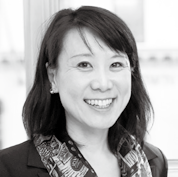 ガイガー 敦子
ガイガー 敦子
 ガイガー 敦子
ガイガー 敦子
米国法人日本国際交流センターフェロー
国連開発計画プロジェクト・コーディネーター
デラウェア州立大学より、国際関係学博士号取得。
(米国在住)
国連開発計画プロジェクト・コーディネーター
デラウェア州立大学より、国際関係学博士号取得。
(米国在住)
特別インタビュー英語版/English edition of Special Interview
◆ Special Interview/No.399
―Be My Eyes―
Becoming the“eyes”for the visually impaired with the use of technology and the spirit of helping each other
Mr. Will Butler
Vice President, Community, Be My Eyes
Vice President, Community, Be My Eyes
Be My Eyes is an app that was created for the visually impaired and people with low vision* that enables them to connect to volunteers through a live video call on their smartphones when they are in need of visual assistance.
Volunteers can “lend their eyes” by reading out or explaining colors or forms they see on the video that are sent from the visually impaired whether that be a document or a package of a product.
Since its launch in 2015, Be My Eyes has grown into a big community connecting over 200,000 visually impaired users with nearly 4 million registered volunteers across over 150 countries in more than 180 languages.
We have interviewed Mr. Will Butler, the Vice President of Community for Be My Eyes to hear about how they started and the challenges they faced since then.
(Note* : People with low vision are people that face difficulties in their daily lives due to visual handicap.)
Volunteers can “lend their eyes” by reading out or explaining colors or forms they see on the video that are sent from the visually impaired whether that be a document or a package of a product.
Since its launch in 2015, Be My Eyes has grown into a big community connecting over 200,000 visually impaired users with nearly 4 million registered volunteers across over 150 countries in more than 180 languages.
We have interviewed Mr. Will Butler, the Vice President of Community for Be My Eyes to hear about how they started and the challenges they faced since then.
― First of all, please tell us how Be My Eyes started and how it has grown since then.
Be My Eyes started from an idea Hans Jørgen Wiberg, a Danish man, had. Hans himself was suffering from retinal pigmentary degeneration which is an illness that causes gradual loss of vision. When video calls came into place, he thought it could be a convenient tool to get the support when in need. However, he didn’t want to call and bother his friends or families every time when he needed just a little bit of help. On the other hand, once he goes outside, there were many people that were more than willing to help when he was in need. But then again, it wasn’t like he needed a full support all the time.
That was how he came up with the idea of using technology to connect the visually impaired with people willing to help when they are in need. That became the “Be My Eyes” app in 2015.
It is a system that enables the user to press the Call button when he is in need to connect to the volunteer that first picked up the phone. It is in a way a visual version of Uber.
It is a system that enables the user to press the Call button when he is in need to connect to the volunteer that first picked up the phone. It is in a way a visual version of Uber.
― Did Mr. Wiberg develop the app?
As he needed technical support, he partnered with Christian Erfurt (the current CEO) to develop the app and to become joint founders of Be My Eyes.
Currently there are 17 staff members based in Denmark and the US working for the organization. In Denmark, there are 4 web developers managing and developing the 3 apps running on Android, iPhone and web browsers. Isn’t is amazing that with only the 4 of them, they are managing the app that is currently used all around the world?
In addition, there is a core division in Denmark managing the organization such as the Communication Department. In the US, we have 4 to 5 staff members including myself that are working on partnerships and business models.

Be My Eyes is not a nonprofit organization but is a social enterprise that is managed through partnerships with corporations around the globe that are willing to support the community for the visually impaired. Companies such as Google, Microsoft and P&G are amongst them.
By becoming our partners, corporations are able to use the software technology of Be My Eyes. They can, for example, use the software to support their own employees and promote such partnerships as their CSR initiative.
In addition to corporations, we also have a number of nonprofit organizations that are our partners such as a blind dog organization and an organization that supports rehabilitation of the visually impaired. Our partners also are spread across the globe such as the Paralympic Association in Brazil, and other nonprofit organizations in countries such as India and the US. Most recently, we partnered with a nonprofit organization in Italy and have started a specialized service in Italian language.
― Do you only need to register to become a volunteer?
Yes. That simplicity is what is wonderful about Be My Eyes. Individuals can become volunteers by simply registering. It also allows large corporations like Google to participate.
Google has a specialized department that receive calls through Be My Eyes. There are also companies such as Microsoft, P&G and a blind dog organization that have their own specialized line on Be My Eyes which the users can specify and call.
― The companies can thereby improve their customer service.
Exactly. There are nearly 250,000 blind and low-vision users of Be My Eyes. There are even more number of people across the globe that are in need of such service. This number is significant for the business as well.
Our first corporate partner was Microsoft and they have supported us in various ways including providing us with feedback on our technology and design. There was also a problem for visually impaired women that were unable to read the results after taking a pregnancy test on their own. That led to creating a service for them to connect directly and anonymously to P&G specialists through Be My Eyes.
― What was the most challenging thing for you till now?

― Can you share with us some memorable episodes?

― It is a teamwork between users and volunteers.
Exactly! Every call is a team work between users and volunteers. Together, they can build something or fix something. Through Be My Eyes people that do not know each other can connect and become a team to solve problems.
On Twitter you can find a number of moving episodes being posted in variety of languages including Japanese every day.
― Do you mean that volunteers can also feel good?
Yes. Volunteers can also have a wonderful experience. We sometimes joke and say that although Be My Eyes is an app for the visually impaired, we actually may have created it for the volunteers. There are a number of heart moving episodes of users and volunteers alike.
― Do you have any message for the Japanese readers?
I love our Japanese users!
Although the number of users in Japan is still limited, we are happy that there are people that are passionate supporters of Be My Eyes. When our two founders visited Japan and made a presentation at the Apple Store in Kyoto, there were users that said they were big fans of Be My Eyes.
Be My Eyes is already usable in Japanese with thousands of users in Japan. We also have a number of registered volunteers. However, I think we still have a relatively limited number of users as we are not yet well known in Japan. We would like to do everything we can to expand the Be My Eyes community in Japan.
We of course need more volunteers in Japan but we are also in search for a nonprofit organization in Japan that could partner with us.
In addition to organizations that support the visually impaired, as our system is usable for anyone with a mobile phone, we would wish many people to know about our service including organizations that supports the elderly. There are so many cases where a little bit of help by the volunteer could solve the problem when you are alone at home and do not want to bother your friends and families. We would be happy to cooperate with any organization that could help us connect to the people in need of Be My Eyes.
In addition, there are the corporate partners. We have had discussions with a few Japanese corporations with the momentum of the Tokyo Olympics. However, we have not found a corporate partner in Japan so far. There are a number of top class corporations in Japan in terms of technology or design. We will be very happy to work together with them as partners to help the 100s of millions of blind and low vision people across the world.
Although the number of users in Japan is still limited, we are happy that there are people that are passionate supporters of Be My Eyes. When our two founders visited Japan and made a presentation at the Apple Store in Kyoto, there were users that said they were big fans of Be My Eyes.
End of the Special Interview, "Philanthropy" August 2020 / No.399
機関誌『フィランソロピー』No.399/2020年8月号 特別インタビュー おわり

